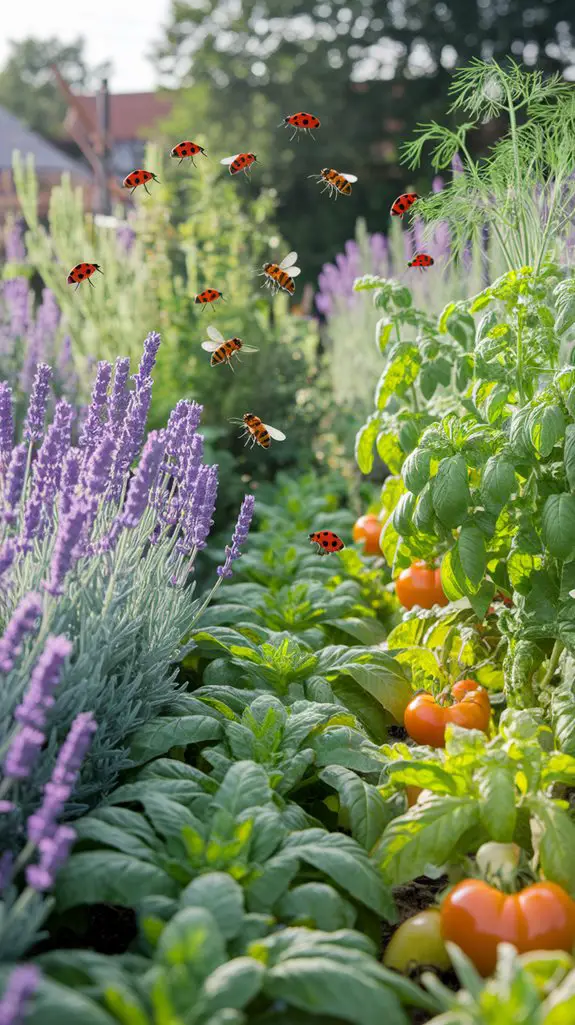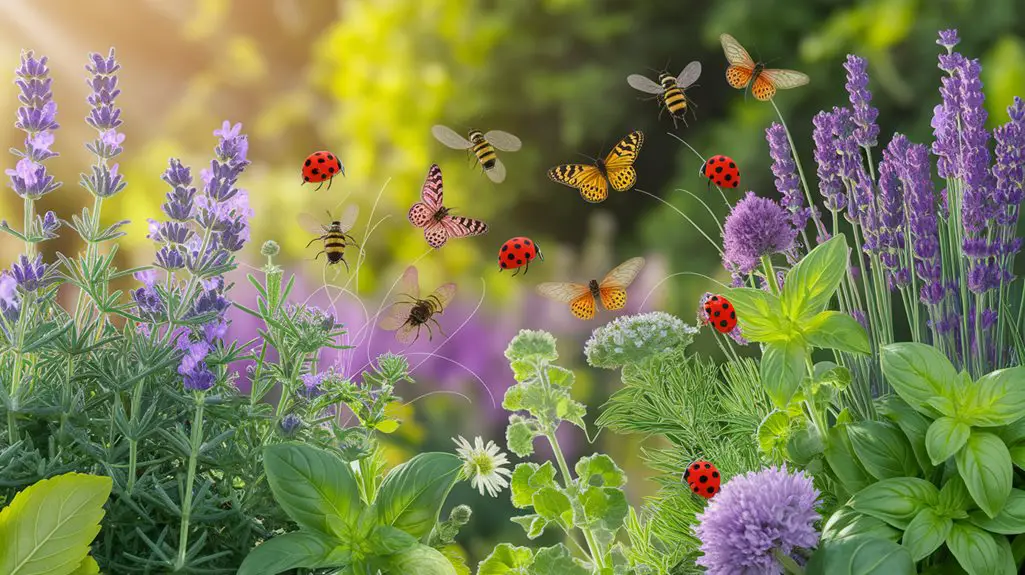If your garden's ecosystem seems to be experiencing a shortage of six-legged allies, herbs might offer the perfect solution. You'll find that strategically planted herbs can transform your landscape into a hub for beneficial insects that pollinate crops and control pest populations. These aromatic plants provide essential nectar, pollen, and habitat while enhancing your garden's biodiversity. Understanding which herbs attract specific beneficial insects will equip you with powerful tools for natural pest management without chemical interventions.
The Role of Beneficial Insects in Your Garden Ecosystem
While many gardeners focus solely on plant selection and soil health, a thriving garden ecosystem depends considerably on beneficial insects that serve as nature's own pest control system.
These invertebrates fall into three functional categories: predators, parasitoids, and pollinators.
Predatory insects like ladybugs and lacewings consume pest species directly, while parasitoids lay eggs inside host pests, eventually killing them.
Pollinators, including bees and butterflies, transfer pollen between flowers, enabling fruit and seed production.
You'll recognize a balanced ecosystem when pest populations remain below damaging thresholds without chemical intervention.
This equilibrium results from complex ecological relationships where beneficial insects regulate pest numbers through predation and parasitism. Additionally, creating a habitat for these beneficial insects can significantly enhance their presence and effectiveness in your garden.
Top Herbs That Attract Pollinators and Predatory Insects

Certain herbs function as powerful insect magnets in your garden ecosystem, attracting both pollinators and predatory species through specialized floral structures and biochemical properties. Each herb's unique nectar composition, volatile compounds, and flowering duration determines its efficacy in supporting beneficial insect populations. Additionally, creating a pollinator-friendly herb garden can enhance the overall biodiversity of your garden, supporting not only insects but also other wildlife.
| Herb | Primary Insects Attracted |
|---|---|
| Dill | Parasitic wasps, hoverflies |
| Lavender | Bees, butterflies, lacewings |
| Mint | Predatory wasps, honeybees |
| Fennel | Ladybugs, tachinid flies |
| Borage | Long-tongued bees, syrphid flies |
When positioning these herbs, you'll maximize efficacy by planting in clusters rather than isolated specimens. This concentrates floral resources, creating microhabitats that provide both nectar sources and protective cover for beneficial insects throughout their life cycles.
Designing Your Herb Garden for Maximum Insect Attraction

To effectively design an herb garden that maximizes beneficial insect attraction, you'll need to contemplate spatial organization, ecological diversity, and seasonal dynamics.
Arrange herbs in clusters rather than isolated specimens—groups of at least three plants per species create sufficient visual and olfactory signals to draw insects from a distance.
Incorporate structural diversity by integrating herbs of varying heights: low-growing thyme and oregano, mid-height sage and lavender, and taller dill and fennel. This vertical stratification provides multiple microclimates and feeding zones.
Ensure continuous blooming by selecting herbs with sequential flowering periods. Early season bloomers like chives should complement mid-season performers such as hyssop, followed by late-season herbs like anise hyssop. Additionally, creating a wildlife-friendly garden will enhance the overall ecosystem, making it more inviting for beneficial insects.
Position your garden where it receives 6-8 hours of sunlight daily, with windbreaks to create sheltered feeding areas.
Companion Planting: Herbs and Vegetables Working Together

Companion planting with herbs and vegetables establishes mutually beneficial relationships that enhance garden productivity while simultaneously supporting beneficial insect populations.
Strategic placement of herbs throughout vegetable rows creates microclimates that disrupt pest feeding patterns and attract predatory insects.
Plant dill and fennel near brassicas to lure parasitic wasps that control cabbage worms. Position basil alongside tomatoes to repel hornworms while attracting pollinators. Thyme's low-growing habit works effectively between lettuce rows, deterring aphids while providing ground cover. Chives interplanted with carrots deter carrot rust fly through their pungent sulfur compounds.
Additionally, incorporating companion planting ideas can further optimize your garden's ecosystem and improve harvest quality.
You'll achieve maximum efficacy by analyzing companion compatibility based on growth habits, root structures, and allelopathic properties.
Avoid combining herbs that compete for resources—mint's aggressive growth pattern, for instance, overwhelms most vegetables unless properly contained.
Seasonal Strategies for Year-Round Beneficial Insect Support

While beneficial insect populations fluctuate throughout the growing season, implementing strategic herb plantings calibrated to specific seasonal conditions creates continuous ecological support mechanisms.
In spring, plant early-blooming herbs like chives, cilantro, and dill to attract pollinators emerging from dormancy. These establish vital food sources when few alternatives exist.
Summer requires heat-tolerant varieties—oregano, thyme, and basil—that provide nectar during peak predatory insect activity periods. Stagger plantings to guarantee continuous blooming cycles.
Fall strategies should include late-season bloomers such as mint, sage, and anise hyssop to sustain beneficial populations preparing for winter. Leave some herbs unharvested as shelter.
During winter, maintain herb debris as overwintering habitat while planning next season's succession planting schedule to optimize fragrant herb gardens and retention.
Creating Insect Habitats Beyond Just Growing Herbs
Effective beneficial insect management extends considerably beyond herb cultivation alone, requiring complementary habitat structures that address distinct lifecycle requirements.
You'll need to install insect hotels with various-sized hollow tubes for solitary bees and predatory wasps. Incorporate small rock piles and unmulched soil patches to provide hibernation sites for ground beetles and assassin bugs.
Water features, even shallow dishes with pebbles, support moisture-dependent species like damselflies that consume pest larvae. Maintain undisturbed leaf litter in designated zones as overwintering microhabitats for ladybugs and lacewings.
Leave some dead wood in place—logs and stumps host decomposers that attract predatory arthropods. Additionally, fostering backyard wildlife can enhance your garden's natural pest control capabilities.
These structural elements, strategically positioned near your herb gardens, create a thorough ecological network that sustains beneficial insect populations throughout their complete developmental cycles.
Common Garden Pests and Their Natural Predators
Garden pest management begins with accurate identification of both destructive species and their biological controls.
Aphids, which extract plant sap and spread diseases, are controlled effectively by ladybugs, lacewings, and hoverflies. For caterpillars that devour foliage, parasitic wasps and predatory beetles provide excellent regulation.
Spider mites, troublesome in hot, dry conditions, become prey for predatory mites and minute pirate bugs.
You'll encounter slugs and snails in moist environments where they can devastate seedlings. Ground beetles and birds will help manage these populations.
Whiteflies, which cluster beneath leaves causing yellowing, are targeted by parasitic wasps and bigeyed bugs.
To maximize these relationships, observe pest patterns in your garden and incorporate herbs like dill, fennel, and thyme that attract specific beneficial insects corresponding to your predominant pest challenges. Additionally, using natural herbs can help repel common garden pests while enhancing the presence of beneficial insects.
Conclusion
You've now established a functional ecosystem within your garden by strategically incorporating herbs. Research shows that gardens with diverse herb plantings can increase beneficial insect populations by up to 80% compared to monoculture landscapes. This biological diversity translates into reduced pest pressure and improved crop yields. Continue monitoring your insect visitors and adjust your herb selections seasonally to maintain this ecological balance year-round.




